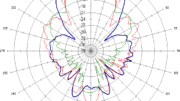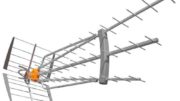What you see above you is a coaxial surge protector. It’s this one, in fact. While most coaxial surge protectors are designed for 50-ohm cables with N connectors, this one is designed for home cell booster systems with F connectors. It’s a mysterious piece of equipment, and a lot of folks don’t know what to do with it. This particular one has a lug for a ground wire, while most of them don’t. So what’s the deal?
What is a coaxial surge protector (or lightning arrestor)
This is a little device that you put in between your antenna and your indoor equipment. It’s supposed to do things. First of all, it stops power surges that may travel up the line and potentially damage cables. Second, it’s supposed to protect your home, RV, or boat from a lightning strike.
From the point of view of surge protection, my guess is that it works pretty well. I’ve never heard of a case where surge protection damaged an outdoor cable but I’m willing to admit it could happen. Better safe than sorry I’d guess.
On the other hand, it’s silly to think that a small device like this is going to deflect all the energy from a lightning strike. The way it is supposed to work, there’s a gas-discharge tube inside the device which lets signals through but blocks large amounts of current. If you provide that current somewhere else to go (like through a ground wire) then it should flow safely away from your equipment. I’m a little skeptical of that claim. Lightning is extremely powerful and the chances are that it’s going to melt the wire ahead of that surge protector and probably start a fire. I’m not saying you shouldn’t use one, only that it should be part of a larger lightning control strategy.
Should these devices be grounded?
More grounding is better grounding, in general. If you have the opportunity to ground something you should. If you buy a surge protector with a ground lug, use it. But, and I’m going to italicize it, don’t use it instead of grounding the antenna. The idea of grounding the antenna is not to help it survive a lightning strike. If lightning strikes your home, there’s going to be damage. You want to avoid that. Properly grounding a satellite dish or antenna will help keep static electricity from building up around that antenna. Without that static buildup there’s not going to be a lightning strike.
The best way to prevent static buildup is to create a nice easy path for it to dissipate into the ground. That means a ground block as close as possible to the antenna, and dedicated ground wire running to a ground rod or cold water pipe. If you don’t have it close to the antenna, you’re just making it harder for electricity to dissipate. If you make it harder to dissipate, it’s going to build up. And then, boom.
Two other things I wanted to tell you
There were two other questions that came up when I researched this article. Here are the answers to those questions.
Should I use a surge protector with a satellite dish?
In general, no. Surge protectors and lightning arrestors specifically block electricity from traveling between your indoor equipment and the dish. The dish needs electricity to work. It may get enough electricity if you use a surge protector, or it may not. The whole thing isn’t designed for it.
Do I need to ground my RV?
Yes, yes you do. You should always ground your RV. Generally connecting to power or accessory cables that run through the ground will do it. However, that old story your mom told you of how vehicles are grounded because they’re on rubber tires— that’s just not true.
Find out more from Solid Signal
Solid Signal is your home for everything you need to live your best digital life! Shop at SolidSignal.com for everything you could possibly want. If you can’t find what you’re looking for, or if you need extra help, call us at 888-233-7563! We’re here during East Coast hours. If it’s after hours, fill out the form below and we’ll get right back to you.





